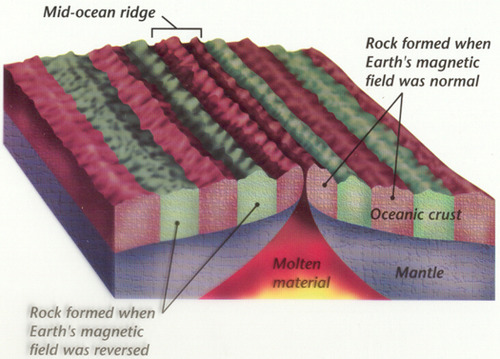Support For Hess Theory





Support For Hess Theory
Support For Hess Theory: The theory of seafloor spreading proposed by Hess is supported by three important pieces of evidence :
Magnetic Striping : In the 1950's, scientists discovered that many rocks contained the magnetic iron oxide mineral called magnetic. Magnetic has a north-seeking pole and a south-seeking pole, just like a compass needle. When molten rock solidifies, all the magnetic particles in a line up with Earth's magnetic field to point in the same direction. In this way, the direction of Earth;s magnetic field at the time is preserved in the rock.
The direction of the magnetic field of these magnetic particles can be detected with a device called a magnetometer. During World War II. US navy magnetometers showed that there were bands of alternating strong and weak magnetism on the sea floor. These bands were parallel to the mid-ocean ridges.
Geologists found that as they went away from the ridge, the magnetic field preserved in the rocks kept changing. At the start, the rocks had north pointing in the correct. At the start, the rocks had north pointing in the correct direction (towards what is nor Earth's north pole). Suddenly the direction of north changed to the opposite direction. North became south, then changed back again. This was very puzzling, because there was no way that the rocks could have spun around. Instead, it indicated that Earth's magnetic field had changed every few million years.
These patterns of strips of rocks with alternating magnetism are called magnetic striping. The patterns on either side of the ridge are symmetrical-rocks at a particular distance from the ridge on one side always have their magnetic fields pointing in the same direction as rocks the same distance away on the other side. That is, their magnetic fields both point to the current position of north, or both point to the current south.
More research into magnetic striping led geologists to support Hess theory about seafloor spreading. They concluded that there were great cracks in the crust and that magma rose up and added to each side of a crack to from new crust on the sea floor. New sea floor was being added equally on each side of the ridge.
This is why the pattern of magnetism was symmetrical-the rocks at equal distances on each side of the ridge were formed at the same time and so had their magnetic fields pointing in the same direction. As Earth's magnetic field changed over many millions of years, so did the magnetic direction preserved in the rocks .

Age of the sea floor : - More evidence supporting the theory of seafloor spreading came from the dating of rocks on the sea floor.
Sediment thickness : - The sedimentary layers on the ocean floor become thicker as you away from the ridges. This was interpreted by geologists as showing that sediments had been falling for longer on the rocks on the sea floor furthest away from the ridges.
The pattern of strips of rock with alternating magnetism is called as _____________ . | |||
| Right Option : A | |||
| View Explanation | |||
Which of the following is the evidence of Hess theory ?
| |||
| Right Option : D | |||
| View Explanation | |||
The device used to detect the magnetic field is called as ____________ | |||
| Right Option : B | |||
| View Explanation | |||
Students / Parents Reviews [10]
A marvelous experience with Abhyas. I am glad to share that my ward has achieved more than enough at the Ambala ABHYAS centre. Years have passed on and more and more he has gained. May the centre flourish and develop day by day by the grace of God.

Archit Segal
7thAbhyas Methodology is very good. It is based on according to student and each child manages accordingly to its properly. Methodology has improved the abilities of students to shine them in future.

Manish Kumar
10thMy experience with Abhyas is very good. I have learnt many things here like vedic maths and reasoning also. Teachers here first take our doubts and then there are assignments to verify our weak points.

Shivam Rana
7thMy experience was very good with Abhyas academy. I am studying here from 6th class and I am satisfied by its results in my life. I improved a lot here ahead of school syllabus.

Ayan Ghosh
8thAbhyas is a complete education Institute. Here extreme care is taken by teacher with the help of regular exam. Extra classes also conducted by the institute, if the student is weak.

Om Umang
10thIt has a great methodology. Students here can get analysis to their test quickly.We can learn easily through PPTs and the testing methods are good. We know that where we have to practice

Barkha Arora
10thAbout Abhyas metholodology the teachers are very nice and hardworking toward students.The Centre Head Mrs Anu Sethi is also a brilliant teacher.Abhyas has taught me how to overcome problems and has always taken my doubts and suppoeted me.

Shreya Shrivastava
8thIt was a good experience with Abhyas Academy. I even faced problems in starting but slowly and steadily overcomed. Especially reasoning classes helped me a lot.

Cheshta
10thIt was good as the experience because as we had come here we had been improved in a such envirnment created here.Extra is taught which is beneficial for future.

Eshan Arora
8thOne of the best institutes to develope a child interest in studies.Provides SST and English knowledge also unlike other institutes. Teachers are co operative and friendly online tests andPPT develope practical knowledge also.
